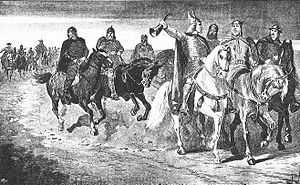Title: The Relation of the Hrolfs Saga Kraka and the Bjarkarimur to Beowulf
A Contribution To The History Of Saga Development In England And The
Scandinavian Countries
Author: Oscar Ludvig Olson
I_BỌÐVARSÞÁTTR._
The question whether Saxo Grammaticus’ account of Biarco’s fight with a
bear or the account in the _Hrólfssaga_ of Bjarki’s fight with a winged
monster is the earlier version of the story has been the subject of much
discussion, as has also the possible identity of Bjarki’s (Biarco’s)
exploit with one or both of Beowulf’s exploits (his slaying of Grendel
and the dragon). The latter problem is still further complicated by the
introduction of two beasts in the _Bjarkarímur_ where Saxo and the
_Hrólfssaga_ have only one, and the introduction in _Beowulf_ of
Grendel’s mother, who makes her appearance in order to defend her
offspring and also is slain.
In this dissertation an attempt will not be made to clear up the whole
of this complicated matter. But an attempt will be made to solve some of
the problems involved. It will be shown that the stories in the
_Bjarkarímur_ of the slaying of the wolf and the bear at the court of
Hrolf Kraki[1] are based on the story in the _Hrólfssaga_ of the slaying
of the winged[2] monster. The explanation of the origin of the dragon
and the interpretation of the whole dragon story in the _Hrólfssaga_,
both of which have hitherto been wanting, will be given. From this it
will be seen that this story in the _Hrólfssaga_ is based on the story,
related in the second book of Saxo’s _Gesta Danorum_[3], of Bjarki’s
slaying the bear.
_Earlier Opinions in Regard to the_ BỌÐVARSÞÁTTR, _the_ BJARKARÍMUR,
_and Related Matters_.
Gisli Brynjulfsson, the first writer, apparently, to call attention to
the similarity between Beowulf’s combat with Grendel and Bjarki’s combat
with the winged monster, identified the story in the _Hrólfssaga_ of
Bjarki’s fight with the winged monster with the story in _Beowulf_ of
Beowulf’s fight with Grendel. That it was a sea-monster (havjætte) that
caused the trouble in Denmark, while it was a mountain-troll that caused
the trouble in Norway, he thought was as characteristic as anything
could be.[4]
Gregor Sarrazin would identify Bjarki with Beowulf. He calls
attention to striking similarities between the stories about the two men
and attempts to identify the word “Bọðvar,” etymologically, with the
word “Beowulf.” The translator, as he calls the author of _Beowulf_,
may, through misconception, have regarded “var,” the second part of the
name “Bọðvar,” as “vargr” and translated it faithfully into AS. “wulf.”
This, combined with other changes, which he discusses and illustrates,
that might have taken place in the name in its passage from very early
Danish to Anglo-Saxon, could have caused the Scandinavian name “Bọðvar”
to be rendered “Bēowulf” in Anglo-Saxon.[5]
Sophus Bugge thought that saga-characteristics earlier ascribed to
Beowulf had been transferred, in Danish tradition, to Bjarki. The story
of Bjarki’s fight with the winged monster he regarded as acquired from
contact with the story of Beowulf’s fight with the dragon. He showed
that the words “Bọðvar” and “Bēowulf” are not etymologically related,
but that “Bọðvar” is the genitive of “bọð,” meaning “battle,” so that
“Bọðvar Bjarki” means “Battle Bjarki.” He called attention to the fact
that Saxo regarded Bothvar’s real name as Bjarki (Lat. Biarco), that the
_Bjarkamál_ was called after that name, and, furthermore, that Saxo
ascribed to Bjarki the words “belligeri cepi cognomen”.[6]
Sarrazin regards the story of Bjarki’s journey from Sweden to Denmark
and subsequent exploit there, with which he identifies the corresponding
journey and exploit of Beowulf, as an embodiment of the Balder and Frey
cult. He thinks it may be interpreted as the southward journey of the
sun in the autumn and its contest with frost and mists when it reaches
its southern limit (i.e., Denmark, according to the ancient conception
of the people of the Scandinavian peninsula); or it may be interpreted
as the introduction of the Balder-cult from Sweden into Denmark.[7]
Bernhard ten Brink agreed with Karl Müllenhoff,[8] that, on the one
hand, there is really no similarity between the Beowulf story and Saxo’s
account of Bjarki, in which the blood-drinking episode is the main
point, and, on the other, between Saxo’s account and that in the
_Hrólfssaga_, which has too much the nature of a fairy tale to be
ancient tradition. He agreed with Bugge, that Bjarik’s combat with the
winged monster shows contact with the story of Beowulf’s fight with the
dragon.[9]
Sarrazin, replying to ten Brink, scouts the idea that a poem, such as
_Beowulf_, which was completely unknown in England after the eleventh
century, should, after this time, be well known in Scandinavian
countries and exert a notable influence there.[10]
G. Binz does not think that Sarrazin’s attempt to identify Bjarki with
Beowulf is sufficiently substantiated and shows by a list of names,[11]
dating from the twelfth century and found in the Northumbrian _Liber
Vitae_, that the story about Bjarki was probably known at an early date
in northern England.[12]
Sarrazin thinks that perhaps Beowulf married Freawaru, Hrothgar’s
daughter, as, similarly, Bjarki, according to the _Hrólfssaga_, married
Drifa, the daughter of Hrothgar’s nephew, Hrolf Kraki; that the troll
which supports Hrolf Kraki’s enemies in Hrolf’s last battle is a
reminiscence of the dragon in _Beowulf_; and that, owing to the change
of taste and other causes that occurred in the course of time, the
Beowulf story developed into the form in which it is found in the Bjarki
story in the _Hrólfssaga_.[13]
Thomas Arnold concedes that there may be a faint connection between the
Bjarki story and the Beowulf story, but he rejects Sarrazin’s theory
that the Anglo-Saxon poem is a translation from the Scandinavian (see p.
8).[14]
B. Symons takes the story of Bjarki’s fight with the winged monster to
be a fusion of the story of Beowulf’s fight with Grendel and that of his
fight with the dragon.[15]
R.C. Boer identifies Bjarki with Beaw. In the West-Saxon line of kings,
Beaw succeeded Scyld; in the poem _Beowulf_, Beowulf, the Danish king,
succeeded Scyld; in Saxo’s account, Frothi I succeeded Scyld. Frothi is
represented as having killed a dragon.
According to the _Hrólfssaga_, Bjarki killed a dragon. As Beaw in one
account occupies the same position in the royal line as Frothi in
another and Beowulf, the Dane, in a third, Boer thinks that Bjarki’s
exploit and Frothi’s exploit are the same one and that to Beowulf, the
Dane, the same exploit was also once attributed. In Saxo’s account,
Bjarki is a king’s retainer; and Boer thinks his exploit has been
differentiated from that of Frothi, who is a king. In _Beowulf_, he
thinks, the exploit has been transferred from Beowulf, the Danish king,
to Beowulf, the Geat, and that the differentiation of the deed into two
exploits has been retained–Beowulf, as a king’s retainer, slaying
Grendel, and later, as a king, killing a dragon. This identifies
Bjarki’s slaying of the winged monster with Beowulf’s slaying of
Grendel. In Saxo’s account of Bjarki, Boer thinks that the dragon has
been stripped of its wings and changed to a bear.[16]
Finnur Jónsson regards the story in the _Hrólfssaga_ of Bjarki’s slaying
the winged monster as a reflection, though a feeble one, of the Grendel
story in _Beowulf_.[17]
Axel Olrik, who, more extensively than any other writer, has entered
into the whole matter, of which the problems here under consideration
form a part, does not think there is any connection between _Beowulf_
and the _Hrólfssaga_.[18] He regards the stories in the _Bjarkarímur_ of
Bjarki’s slaying the wolf and Hjalti’s slaying the bear as earlier
compositions than the corresponding story in the _Hrólfssaga._[19] The
addition of “Bothvar” to Bjarki’s name he thinks was acquired among the
Scandinavians in the north of England,[20] where the Bjarki story, by
contact with the story of Siward, Earl of Northumberland, acquired the
further addition of Bjarki’s reputed bear-ancestry.[21] The stories in
the _Grettissaga_, _Flateyjarbók_, and _Egilssaga_ to which counterparts
are found in _Beowulf_, he believes to have been acquired by contact
either with the Beowulf legend or, perhaps, with the Anglo-Saxon epic
itself.[22]
Finnur Jónsson thinks that the stories in the _Bjarkarímur_ of Bjarki’s
slaying the wolf and Hjalti’s slaying the bear are later compositions
than the story in the _Hrólfssaga_ of Bjarki’s slaying the winged
monster, and supports this opinion by maintaining that the monster in
the saga is a reminiscence, though altered and faded, of Grendel in
_Beowulf_.[23]
Sarrazin regards the cowardly, useless Hott, Bjarki’s companion, as a
personification of the sword Hrunting, which fails Beowulf in his fight
with Grendel’s mother. But Hjalti, as Hott is called after he has become
brave and strong, he regards as a personification of the giant-sword
with which Beowulf dispatches Grendel’s mother. Sarrazin would also
identify the giant-sword, which is said to have a golden hilt (gylden
hilt), with the sword Gullinhjalti in the _Hrólfssaga_.[24]
Max Deutschbein sees a connection between the Bjarki story and the
_Gesta Herwardi_ that would tend to establish the story in the
_Bjarkarímur_ as earlier than the corresponding story in the
_Hrólfssaga_.[25]
H. Munro Chadwick, basing his opinion on the similarity between the
career of Bjarki and that of Beowulf, thinks there is good reason for
believing that Beowulf was the same person as Bothvar Bjarki.[26]
Alois Brandl does not think that Beowulf and Bjarki were the same
person. He calls attention to the difficulty involved in the fact,
which, he says, Olrik has emphasized, that “Bjarki” is etymologically
unrelated to “Biár”; and of troll fights, he says, there are many in
Scandinavian literature.[27]
William Witherle Lawrence thinks that “we may have to do with late
influence of _Beowulf_ upon the _Hrólfssaga_”.[28] He identifies “gylden
hilt” with Gullinhjalti.[29] He regards the stories in the _Bjarkarímur_
of Bjarki’s slaying the wolf and Hjalti’s slaying the bear as earlier
compositions than the story in the _Hrólfssaga_ of Bjarki’s slaying the
winged monster,[30] which, in agreement with Olrik, he regards as “a
special late elaboration peculiar to the _Hrólfssaga_.” He regards
Saxo’s story as earlier than the stories in the _Bjarkarímur_.[31] He
refers to Mogk as believing that the Bjarki story in the saga is a
werewolf myth into which the Grendel motive is woven.[32] He quotes a
passage from Heusler, in which Heusler states that he regards the story
in the _Bjarkarímur_ of the fight with the bear as earlier than the
story in the saga of the fight with the winged monster and that,
furthermore, Beowulf’s fight with Grendel has been transferred to
Bjarki.[33] Lawrence also calls attention to the fact that Gering thinks
there is unmistakable similarity between the Grendel story and the story
of Bjarki’s fight with the winged monster.[34]
Friedrich Panzer identifies Bjarki with Beowulf and regards the story in
question in the _Hrólfssaga_ as a later composition than the
corresponding stories in the _Bjarkarímur_, which he identifies with the
Grendel story.[35] “Gylden hilt” he identifies with Gullinhjalti;[36]
and Hott-Hjalti, whom Sarrazin regards as a personification of swords in
_Beowulf_, he identifies with Hondscio, Beowulf’s companion who is
devoured by Grendel.[37]
Submitted by Lowell Armstrong (Ross Velk) 12/15/2013


Leave a Reply